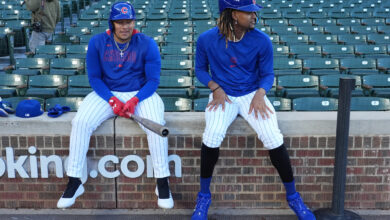
Visual Display of Cubs’ Payroll Ranks Since 2010 May Offer Key to Competitiveness
In the interest of full disclosure, I’m in one of those creative doldrums that makes it difficult to come up with anything interesting. The Cubs sure aren’t making it any easier, what with their waiver claim on depth catcher Brian Serven standing as their only big-league addition of the offseason. There are only so many times I can write about Jed Hoyer seemingly prioritizing value over improvement, and I don’t have the inclination to point out how Sean Manaea would have been a good target.
However, the below visual from Scott Lindholm got my wheels spinning enough to make this feel like a worthwhile topic. It’s really more like an itch in a spot you can’t quite scratch because my thoughts on it are heading in more than one direction without any sense of satisfaction. Take a look and we’ll meet back on the other side to discuss further.
#Cubs payroll ranks, 2010-2023, @baseball_ref data. I enlarged the size of the teams to better see how the other teams ranked. pic.twitter.com/XoC5oPhFbk
— Scott Lindholm ? (@ScottLindholm) January 7, 2024
My immediate reaction is that it’s unconscionable for a team with the Cubs’ revenue to be operating outside the top 10 for more than a year at a time. There’s a great deal of nuance in those figures, of course, so we’re cutting with a chainsaw rather than a scalpel and need to understand that context. At the same time, I go back to the idea that baseline spending should be higher on a more regular basis.
But that gives rise to another thought, which is that spending hasn’t had a direct correlation to winning. Or at least not winning in the biggest way. During their most successful run from 2015-17, the Cubs ranked no higher than seventh among MLB payrolls. When they ranked among the top four over the three subsequent seasons, however, they failed to win a single postseason game.
The most recent three seasons have seen them outside the top 10 and without a postseason appearance as Hoyer’s rebuild continues. There are still quite a few significant free agents remaining and the landscape could shift dramatically once those deals are all settled, so the Cubs may rise or fall significantly by the time the season starts.
Regardless of how everything ends up shaking out, it’s pretty clear that the key is to spend aggressively without crossing into recklessness. That’s clearly different from what the Mets have done, but it’s also a far cry from the more value-based approach Hoyer appears to be following. Being top-5 probably means the payroll is bloated while falling in the 6-10 range provides more margin for error from a talent perspective.
I maintain that we will probably see some activity prior to Cubs Convention, though it’s entirely possible — likely, even — that it’ll be February before the roster is set. Let’s put a pin in this and circle back around once spring training starts and then again after the season.

